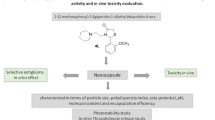Abstract
Purpose
Antineoplastic RNAse proteins, also known as Amphibinases, have been shown effective against various solid tumors but were found selectively neurotoxic to Purkinje cells in the cerebellum. This work describes the use of a waxy biodegradable poly(ricinoleic-co-sebacic acid) for the local controlled delivery of cytotoxic amphibinases in the parietal lobe of the brain in an attempt to overcome cerebellar neuronal toxicity while affecting glioma cells.
Methods
Amphibinase analogues were encapsulated in poly(ricinoleic-co-sebacic acid) formulations using mix-melt technology and loaded onto surgical foam. In-vitro release was monitored by BCA colorimetry and by RNAse specific bioactivity. The implants were inserted into rat brains bearing 9L glioma to assess toxicity and efficacy.
Results
The various formulations showed extended linear release for several weeks with minimal burst effect. Best in-vivo efficacy was obtained with ACC7201 containing implants, resulting in the extension of the median survival from 13 to 18 days with 13% long-term survivors.
Conclusion
Antineoplastic proteins were released from a p(SA-RA) polyanhydride implants in a controlled manner, providing efficacy against 9L glioma, while evading neurotoxicity in the cerebellum. The controlled release of Amphibinases forms the potential for a new therapy against brain tumors.







Similar content being viewed by others
References
Lesniak MS, Brem H. Targeted therapy for brain tumors. Nat Rev Drug Discov 2004;3:499–508. doi:10.1038/nrd1414.
Stupp R, Mason WP, van den Bent MJ, Weller M, Fisher B, Taphoorn MJ, et al. Radiotherapy plus concomitant and adjuvant temozolomide for glioblastoma. N Engl J Med 2005;352(10):987–96. doi:10.1056/NEJMoa043330.
Attenello FJ, Mukherjee D, Datoo G, McGirt MJ, Bohan E, Weingart JD, et al. Use of Gliadel (BCNU) wafer in the surgical treatment of malignant glioma: a 10-year institutional experience. Ann Surg Oncol 2008;15(10):2887–93. doi:10.1245/s10434-008-0048-2.
Lesniak MS. Novel advances in drug delivery to brain cancer. Technol Cancer Res Treat 2005;4:417–28.
DiMeco F, Li KW, Tyler BM, Wolf AS, Brem H, Olivi A. Local delivery of mitoxantrone for the treatment of malignant brain tumors in rats. J Neurosurg 2002;97:1173–8.
Frazier JL, Wang PP, Case D, et al. Local delivery of minocycline and systemic BCNU have synergistic activity in the treatment of intracranial glioma. J Neurooncol 2003;64:203–9. doi:10.1023/A:1025695423097.
Menei P, Capelle L, Guyotat J, Fuentes S, Assaker R, Bataille B, et al. Local and sustained delivery of 5-fluorouracil from biodegradable microspheres for the radiosensitization of malignant glioma: a randomized phase II trial. Neurosurgery 2005;56(2):242–8. doi:10.1227/01.NEU.0000144982.82068.A2.
Westphal M, Ram Z, Riddle V, Hilt D, Bortey E. Gliadel wafer in initial surgery for malignant glioma: long-term follow-up of a multicenter controlled trial. Acta Neurochir 2006;148(3):269–75. doi:10.1007/s00701-005-0707-z.
Hanes J, Sills AK, Zhao Z, Suh KW, Tyler BM, DiMeco F, et al. Controlled local delivery of interleukin-2 by biodegradable polymers protects animals from experimental brain tumors and liver tumors. Pharm Res 2001;18:899–906. doi:10.1023/A:1010963307097.
Lee I, Lee YH, Mikulski S, Lee J, Covone K, Shogen K. Tumoricidal effects of onconase on various tumors. J Surg Oncol 2000;73:164–71. doi:10.1002/(SICI)1096-9098(200003)73:3<164::AID-JSO10>3.0.CO;2-2.
Mittelman A, Puccio C, Chun H, et al. A new anti-cancer RNase (ONCONASE): preliminary results in patients with breast cancer. 21st Meeting of the International Association for Breast Cancer Research, July 1996.
Mikulski SM, Costanzi JJ, Vogelzang NJ, et al. Phase II trial of a single weekly intravenous dose of ranpirnase in patients with unresectable malignant mesothelioma. J Clin Oncol 2002;20:274–81. doi:10.1200/JCO.20.1.274.
Halicka HD, Murakami T, Papageorgio CN, et al. Induction of differentiation of leukaemic (HL-60) or prostate cancer (LNCaP, JCA-1) cells potentiates apoptosis triggered by onconase. Cell Prolif 2000;33:407–17. doi:10.1046/j.1365-2184.2000.00186.x.
Rybak SM, Newton DL. Review: natural and engineered cytotoxic ribonucleases: therapeutic Potential. Exp Cell Res 1999;253:325–35. doi:10.1006/excr.1999.4718.
Schulenburg C, Ardelt B, Ardelt W, Arnold U, Shogen K, Ulbrich-Hofmann R, et al. The interdependence between catalytic activity, conformational stability and cytotoxicity of onconase. Cancer Biol Ther 2007;6(8):1233–9.
Zhao H, Ardelt B, Ardelt W, Shogen K, Darzynkiewicz Z. The cytotoxic ribonuclease onconase targets RNA interference (siRNA). Cell Cycle 2008;7(20):3258–61.
Matousek J, Soucek J, Slavik T, Tomanek M, Lee JE, Raines RT. Comprehensive comparison of the cytotoxic activities of onconase and bovine seminal ribonuclease. Comp Biochem Phys Part C 2003;136:343–56.
Ourednik J, Ourednik V, Redmond DE, et al. A primate model for cerebellar atrophy using selective lesioning of Purkinje cells by onconase. Exp Neurol 2002;175:423.
Newton DL, Walbridge S, Mikulski SM, et al. Toxicity of an antitumor ribonuclease to purkinje neurons. J Neurosci 1994;14:538–44.
Domb AJ, Nudelman R. Biodegradable polymers derived from natural fatty-acids. J Polym Sci A Polym Chem 1995;33:717–25. doi:10.1002/pola.1995.080330413.
Krasko MY, Shikanov A, Kumar N, Domb AJ. Polyanhydrides with hydrophobic terminals. Polym Adv Technol 2002;13:960–8. doi:10.1002/pat.267.
Krasko MY, Shikanov A, Ezra A, Domb AJ. Poly(ester anhydride)s prepared by the insertion of ricinoleic acid into poly(sebacic acid). J Polym Sci A Polym Chem 2003;41:1059–69. doi:10.1002/pola.10651.
Teomim D, Nyska A, Domb AJ. Ricinoleic acid-based biopolymers. J Biomed Mater Res 1999;45:258–67. doi:10.1002/(SICI)1097-4636(19990605)45:3<258::AID-JBM14>3.0.CO;2-W.
Shikanov A, Shikanov S, Vaisman B, Golenser J, Domb AJ. Paclitaxel tumor biodistribution and efficacy after intratumoral injection of a biodegradable extended release implant. Int J Pharm 2008;358(1–2):114–20. doi:10.1016/j.ijpharm.2008.02.028.
Shikanov A, Domb AJ, Weiniger CF. Long acting local anesthetic-polymer formulation to prolong the effect of analgesia. J Control Release 2007;117(1):97–103. doi:10.1016/j.jconrel.2006.10.014.
Krasko MY, Domb AJ. Pasty injectable biodegradable polymers derived from natural acids. J Biomed Mater Res Part A 2007;83(4):1138–45. doi:10.1002/jbm.a.31395.
Shikanov A, Domb AJ. Poly(sebacic acid-co-ricinoleic acid) biodegradable injectable in situ gelling polymer. Biomacromolecules 2006;7(1):288–96. doi:10.1021/bm050648+.
Tsutsui S, Kataoka A, Ohno S, Murakami S, Kinoshita J, Hachitanda Y. Prognostic and predictive value of epidermal growth factor receptor in recurrent breast cancer. Clin Cancer Res 2002;8:3454–60.
Acknowledgements
We acknowledge Alfacell Inc. for generously providing Ranpirnase. This work was supported in part by NIH NCDDG CA52857.
Author information
Authors and Affiliations
Corresponding author
Rights and permissions
About this article
Cite this article
Slager, J., Tyler, B., Shikanov, A. et al. Local Controlled Delivery of Anti-Neoplastic RNAse to the Brain. Pharm Res 26, 1838–1846 (2009). https://doi.org/10.1007/s11095-009-9893-3
Received:
Accepted:
Published:
Issue Date:
DOI: https://doi.org/10.1007/s11095-009-9893-3




